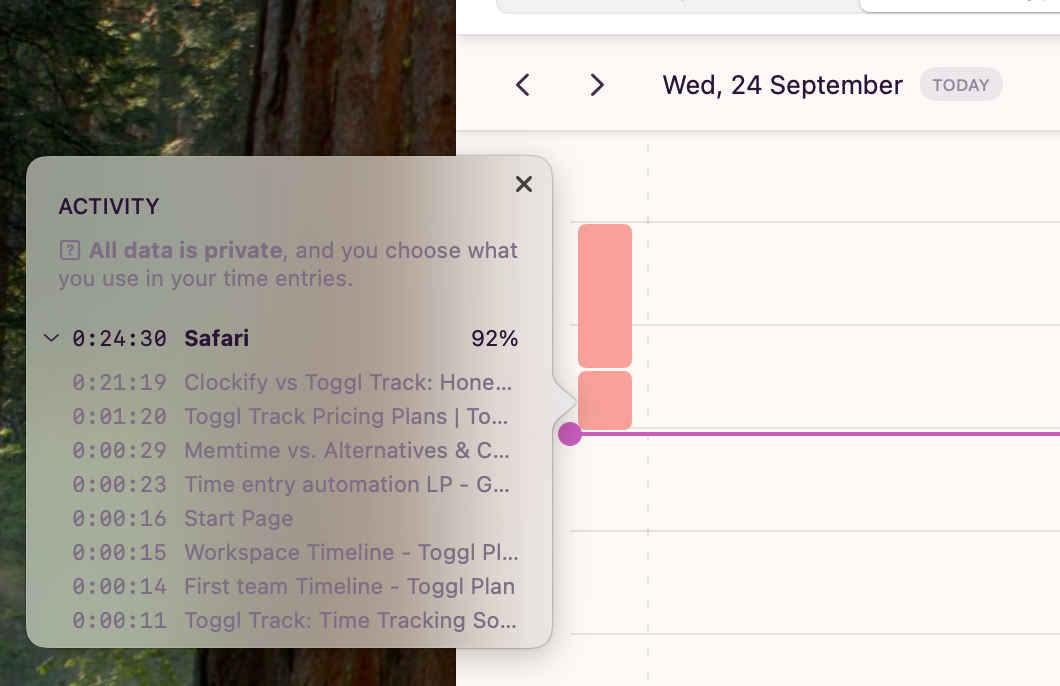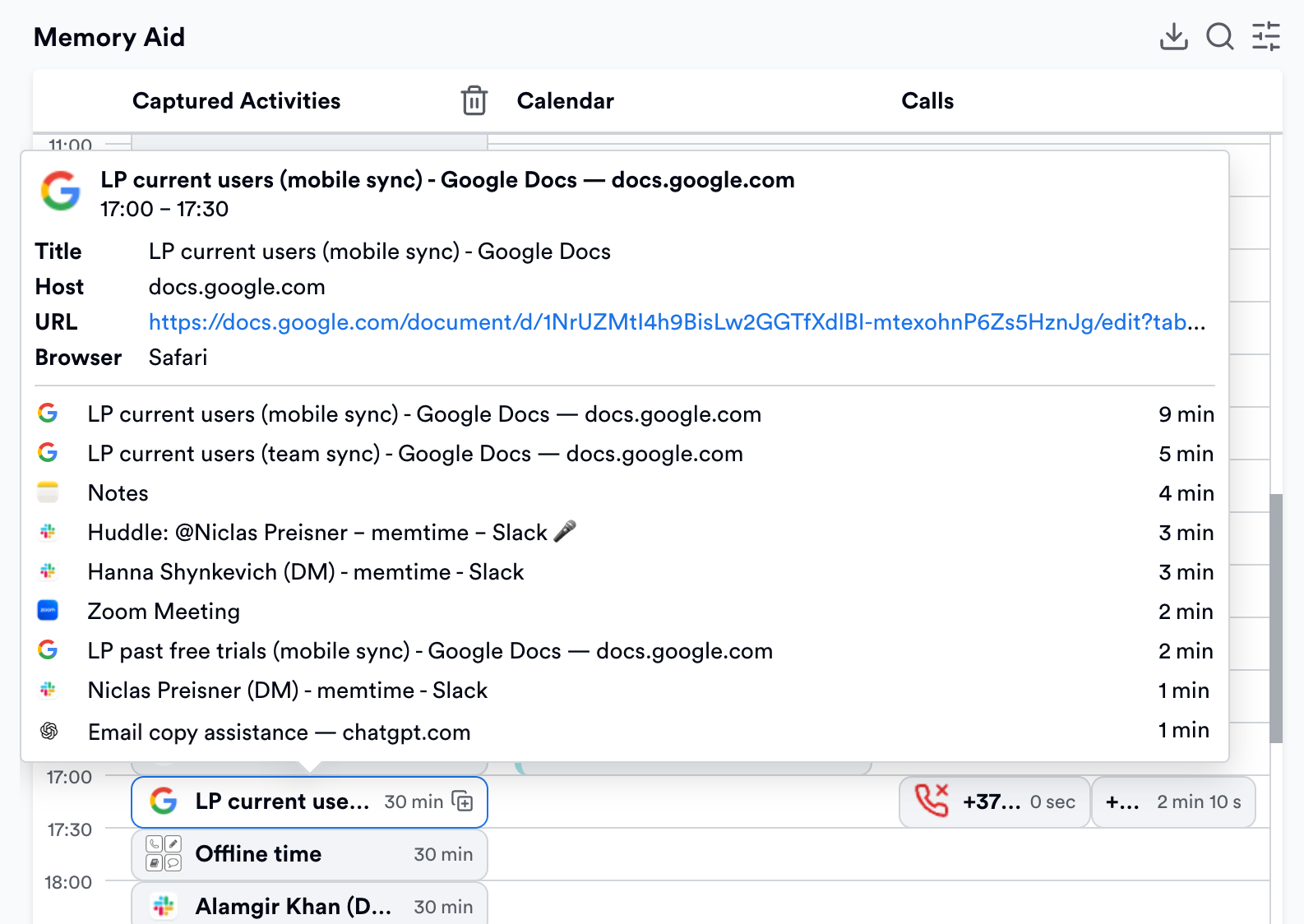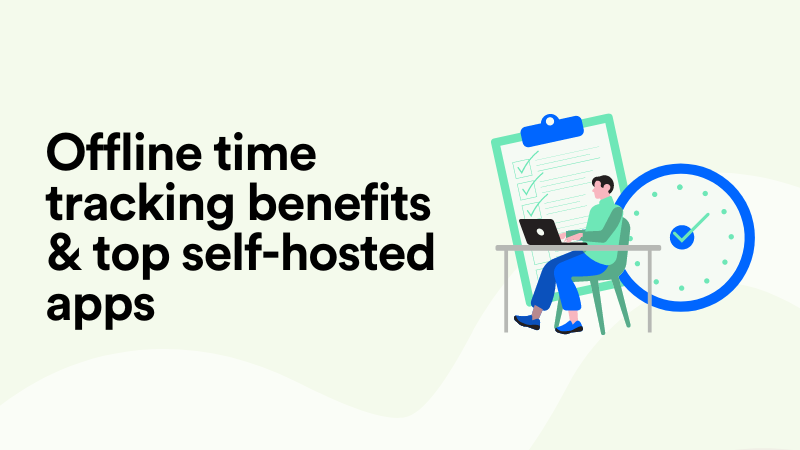Clockify vs Toggl Track: Honest Comparison (and a Smarter Choice)

Let’s be honest, your choice of time tracking tools is more important than your motivation to track time.
As passionate as you may be about recording your work for invoicing and project tracking, the human brain is not wired to concentrate on the work AND remember to make a note for every small task.
Therefore, it’s absolutely essential to choose a time tracker that will back you up when you’re in the zone (or simply multitasking) and can’t be bothered to track time. Especially seeing how the same time tracking tool supplies the information for your client reporting and billing.
In this article, we’re looking at two veteran solutions in the time tracking space – Clockify and Toggl Track. Both have long dominated the discussions around time tracking in the freelancing, SMB, and service business circles.
It won’t be a quick read because it’s a deep dive into the Clockify vs Toggl Track debate. We’ll give you all the answers, details, and receipts to give you the most honest and definitive review of tracking time with Toggl vs Clockify. By the end of this article, you’ll have all the information you need to choose the right time tracker for your business.
But if you can’t be bothered to read the full thing…
Key takeaways
- Clockify is cheaper and has more features – if you want to maximize the value for your buck, Clockify wins in terms of the sheer number of features for the price.
- Toggl is better for ethics and privacy – it offers local storage of activity data while Clockify has employee monitoring features (e.g. screenshots) and charges extra for cloud storage.
- Clockify tracks full URLs – while Toggl only shows the program and window titles, which makes it harder to match recorded activities to projects.
- Toggl has more integrations – against Clockify’s one integration with QuickBooks, Toggl also has Asana, Jira, and Salesforce.
- There are alternatives with better features in the same price range – Clockify and Toggl are good starting points but there are more advanced tools on the market for the same price.
Toggl Track vs Clockify overview
Before we deep dive into features, let’s recap what we know about Clockify and Toggl Track. Both tools have been around for many years and tested by many users for personal and company time tracking purposes.

Here’s what can be established about both tools for the sake of a thorough comparison:
- Both Clockify and Toggl are premium tools with free plans. You don’t have to have a paid subscription to use either time tracker; however, different sets of features will be available with the free versions.
- Both Clockify and Toggl have desktop apps for automatic tracking. In addition to using a manual start/stop timer, you can install a desktop app for Clockify or Toggl Track that automatically captures your activity in computer programs.
- Both Toggl and Clockify have invoicing features. For an additional fee (not included in the free versions), you can create and download invoices in both Clockify and Toggl Track.
- Both Toggl and Clockify have project management features. You can track and manage personal or team projects in both Clockify and Toggl. Some project and team features are premium while others come with the free plans.
- Both Clockify and Toggl offer time reporting. You’ll find a variety of reports in both Toggl Track and Clockify that aggregate your own or your team’s time tracking data.
Now that we’ve covered the basics, let’s look closer at what Clockify and Toggl Track have to offer in terms of core features and value.
Clockify pros
There's a good reason people keep bringing up Clockify whenever there’s talk about time tracking. There are many benefits to choosing this tool over the competition. Let’s go over some of them.
1. Free automatic time tracking
Free unlimited automatic time tracking is not an empty marketing promise with Clockify – you can actually enjoy automatic time tracking with no budget for it. Clockify’s free plan includes both manual and automatic (desktop activity tracking) time tracking without restrictions. Many freelancers’ first-ever time tracker is Clockify precisely for this reason.
2. Tracking with full URLs
If you’ve been in the market for time tracking tools for a while, you know that not all auto-trackers can pick up full URLs when recording your activity in programs. Some will only show the program names while others will display the window titles but not the full URLs.
Clockify, including its free version, can pick up full URLs of the tabs you’re active in. You can retrace your work page by page, making sure your activity in documents matches your project reporting.

3. Free unlimited projects
In addition to automatic activity tracking, you also get unlimited project management in Clockify for free. This includes team projects shared across users, which empowers organizations without any project management budget to take control of their project tracking and team management.
4. Billable rates
Included in Clockify’s free version are billable rates which can be set up for users and projects to analyze profitability. Billable rates are used for invoices and calculating the billable revenue for a project or piece of work. Even though invoices in Clockify are a paid feature, billable rates are available with the free plan, which means you can still calculate your billable value and efficiency using a free online calculator.
Clockify cons
Some of Clockify’s limitations are evident from day 1 of using the tool while others take time to discover. To save you both time and effort, let’s go over the most prominent cons of using Clockify.
1. Visualization & UI
For all the unlimited tracking with full details like URLs and duration down to the second, Clockify’s activity timeline is limited in terms of visualizing your day. You see a list of activities with no option to re-group, zoom in or out on your day, or change the list view.
It can take a while to go over the URLs and make sense of your day, especially if you work in the same program, e.g. a browser such as Safari all day.
2. Privacy & surveillance
There’s no dancing around the fact that Clockify includes employee monitoring features. Its premium features include location tracking, automatic screenshots, and logging time on behalf of employees.

Of course, you don’t have to enable or use the surveillance features in Clockify. Especially for personal time tracking, there’s no reason for concern over workplace surveillance. However, when you introduce Clockify as your team’s time tracking software, you need to be prepared to address legitimate privacy concerns from your employees.
3. Limited integrations
Chances are, you have other tools you need to use in your workflow. You may need to e.g. import projects and export time entries back into your team’s software. This is an example of a two-way sync integration where data travels between your time tracker and other systems.
Clockify only has one sync integration, with QuickBooks, which is a paid feature. The rest of its integrations are embeddable timers that you can add to other tools – but not export or import time tracking data.
4. Limited data storage
You can view your automatically recorded activities for the past 46 days in Clockify. If you want to generate reports with time tracking data older than 1 year, you’ll need to upgrade to a paid version. What it means is that you don’t own your time tracking data – it’s uploaded to the cloud and then retrieved from it for reporting purposes.
In contrast to that, consider a time tracker such as our own Memtime that keeps the only copy of your activity data locally on your computer. You own 100% of your data and can always go back to day 1, no matter how many years have passed.
Toggl Track pros
Let’s now look at the main advantages of tracking time with Toggl Track.
1. Free automatic time tracking
The main and biggest advantage of using Toggl Track is that it’s an automatic time tracker with a free version. Same as Clockify, its appeal is clear to freelancers and small businesses that don’t have a budget for a time tracking tool but still want to reap the benefits of activity tracking in the background.
2. Data privacy
If privacy is important to you, you’ll appreciate the fact that Toggl Track lets you decide whether your activity data is uploaded to the cloud or kept locally on your computer. You can tweak this setting of Toggl’s desktop app and ensure the safety of your data.

3. Automated time entries
Another notable feature of Toggl Track is its automated time entries aka Autotracker. When enabled, the Autotracker lets you match keywords from your captured window titles to projects.
To make full use of the automated time entries in Toggl Track, you need a paid version that allows you to set up projects with tasks. Still, it’s a valuable tool for anybody who wants to streamline their project hour logging.
If you’re curious about automated time entries, check out Memtime where you can set up automation rules not only for window titles but also for document folders, email participants, or even partial URLs. Map keywords and client names to projects with unmatched precision.
4. Downloadable invoices
Downloadable invoices are available in Toggl for anyone who needs to bill clients for their time without investing in accounting tools. You can combine Toggl Track’s automatic time tracking with easy built-in invoicing for a simple yet effective workflow for billable hour tracking.
Toggl Track cons
And now onto the downsides of using Toggl Track you need to be aware of.
1. Limited activity tracking
Toggl Track’s desktop app does not lack precision where activity duration is concerned – you’ll see a breakdown of your day down to the second. However, you’ll only see the names of recorded windows and applications, not the URLs.

As the window titles are not clickable and you can’t copy the full name to see which exact page you were viewing, it can be confusing and time consuming to actually make sense of all the recorded activities. The detail is there but it’s not entirely usable.
2. Limited integrations
Toggl Track has better integrations compared to Clockify – you get the actual sync of project and time data with Asana, Jira, and Salesforce. However, these last two integrations are part of the Premium plan that costs $18/mo per user with an annual subscription. Even for this kind of money, you only get one-way sync with Jira.
For the same subscription fee, you can get many more two-way sync integrations in alternative tools.
Memtime offers 100+ integrations with a 2-way sync of time entries (including ClickUp, Asana, Jira, Clio, Lawcus, FreshBooks, and many more) for the same $18/mo that Toggl charges for just 3 integrations.
3. Steep pricing
Picking up on the previous point, Toggl Track is considerably more expensive than Clockify, for fewer features. The most extensive subscription plan in Clockify is $12.99/mo per user; Toggl’s most expensive plan is $18/mo.
Toggl Track’s pricing puts it in the category of premium time tracking tools, but its features are limited compared to alternatives. Consider any of the above examples (activity tracking, time entry automation, and integrations) to see the difference for yourself.
Clockify vs Toggl for personal use
A time tracker has many applications, the two most common being personal productivity and billable hour tracking. It’s therefore essential to look at time tracking tools through this lens to adequately compare features that you’ll actually be using vs the total number of features available.
Let’s look at Toggl vs Clockify for personal use, i.e. improving productivity and optimizing performance without necessarily focusing on logging billable hours.
As you can see, Clockify and Toggl Track are similar when it comes to personal productivity features. However, looking at the full picture and considering the pros and cons we discussed above, let’s summarize the key findings.
- Both Clockify and Toggl have personal productivity features like the Pomodoro timer, idle time detection, reminders, calendars, etc.
- Toggl Track is better for privacy if personal data protection is a concern you have.
- Clockify is better for activity tracking as it displays full URLs.
- Toggl is more expensive for fewer features but these features might not be as relevant for personal use.
To sum up, both Clockify and Toggl Track are viable options for free automatic time tracking for personal productivity. Ultimately, you have to choose between the privacy of your data (Toggl) or the precision of activity tracking (Clockify).
Clockify vs Toggl for company use
Company use is a whole different conversation. For team management and company-wide time tracking, you need a different set of features which we’ll compare now.
In terms of the sheer number of features, Clockify offers more when it comes to team management. It’s also more affordable. However, we have to keep in mind the compromises that you need to make when introducing your time tracking system to your team.
- Both Clockify and Toggl have team and project management features and are suitable for company use.
- Clockify is cheaper for more features if you’re looking to maximize the quantity of team management tools.
- Clockify is used for employee monitoring and surveillance – even if you’re not planning to enable these features, your team might be concerned about your ethics.
- Toggl Track has better ethics and privacy of user data which your employees are likely to appreciate.
- Toggl has more sync integrations with team software such as Asana, Jira, and Salesforce.
It’s up to you as a manager to go for the cheaper or more ethical option for your team time tracking software. You also have to keep in mind the integrations and ease of use for your employees. Before committing to either Clockify or Toggl, have your team trial both tools so they can make a decision for themselves.
What people say about Toggl vs Clockify
You’re probably curious to hear from actual users of Toggl Track and Clockify to learn from their experience and avoid making the same mistakes. We’ve scanned the reviews for both Clockify and Toggl for the main pointers people make about these tools.
Clockify review average – 4.5/5
Toggl review average – 4.6/5
Now that you’ve reviewed the features and heard from real-life users of Toggl Track and Clockify, you can make an informed decision with your own context and preferences in mind. Whether it’s for personal or company use, low price vs privacy, or maximum features vs number of integrations, the choice is yours.
Clockify & Toggl alternative
We’ve looked at the pros and cons of both Clockify and Toggl Track. It’s time to introduce the smarter alternative for the experience and ethics of tracking time, the quality of data, and the integration into your ecosystem.
Memtime is an automatic time tracker that quietly records every minute of your day via its desktop app – same as Clockify and Toggl. It’s recognized both for personal and company use as the safest time tracking app there is.

What makes Memtime better than Clockify & Toggl
Final thoughts
Choosing the right time tracker will not only save you time and effort but also impact your revenue, focus, productivity, and even reputation if you think about introducing a tool with employee monitoring features to your team. The smarter you choose, the best positioned you are to make the most of your own and your team’s time.
In this blog post, we’ve looked at Clockify vs Toggl Track for personal and company-wide time tracking. We’ve discussed the pros and cons, considered the compromises you’d need to make, and looked at some user reviews to learn from others’ mistakes.
We won’t tell you which tool is better for you because you’re the one who knows the most about your use case and needs. However, we’ve given you the facts to choose wisely and weigh your options before committing to a time tracking provider.
Make sure you trial both Clockify and Toggl mindfully, making note of all the points we’ve highlighted in this article. The more experience you have with actual time tracking software, the more appreciation you develop for well-executed time tracking features and smarter alternatives 😉
Yulia Miashkova
Yulia Miashkova is a content creator with 7 years of hands-on experience in B2B marketing. Her background is in public relations, SEO, social listening, and ABM. Yulia writes about technology for business growth, focusing on automated time tracking solutions for digital teams. In her spare time Yulia is an avid reader and jogger.






